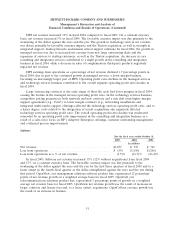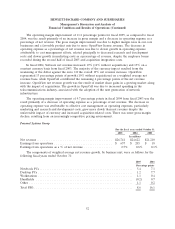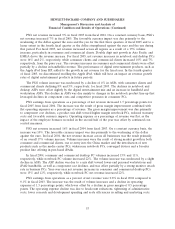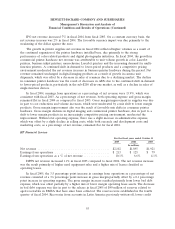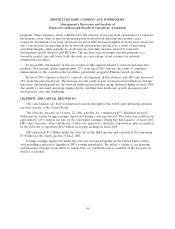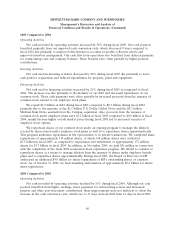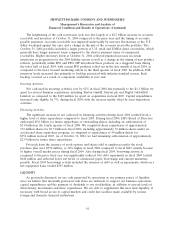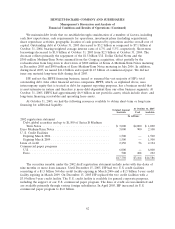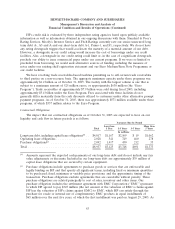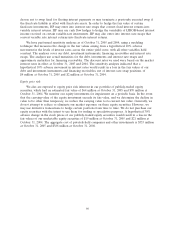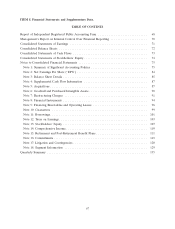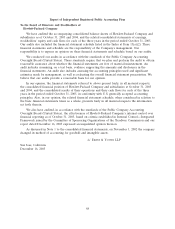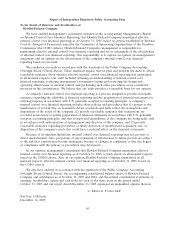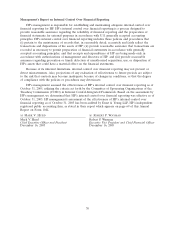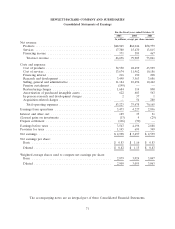HP 2005 Annual Report Download - page 65
Download and view the complete annual report
Please find page 65 of the 2005 HP annual report below. You can navigate through the pages in the report by either clicking on the pages listed below, or by using the keyword search tool below to find specific information within the annual report.HEWLETT-PACKARD COMPANY AND SUBSIDIARIES
Management’s Discussion and Analysis of
Financial Condition and Results of Operations (Continued)
The lengthening of the cash conversion cycle was due largely to a $2.3 billion increase in accounts
receivable and inventory at October 31, 2004 compared to the prior year and the timing of accounts
payable payments. Accounts receivable was impacted unfavorably by currency fluctuations as the U.S.
dollar weakened against the euro and a change in the mix of the accounts receivable portfolio. The
October 31, 2004 portfolio included a larger portion of U.S. retail and EMEA direct receivables, which
generally have longer payment terms compared to the shorter payment terms of commercial
receivables. Higher inventory levels at October 31, 2004 reflected planned increases in certain
inventories in preparation for the 2004 holiday season as well as a change in the timing of new product
rollouts, particularly within IPG and PSG. HP introduced these products on a staggered basis during
the latter half of fiscal 2004, with certain IPG products rolled out in the first month of fiscal 2004, as
compared to the more focused marketing rollout in the third quarter of fiscal 2003. In addition, ESS
inventory levels increased due primarily to backlog associated with industry standard servers. Such
backlog occurred as a result of component availability at year end.
Investing Activities
Net cash used in investing activities rose by 62% in fiscal 2004 due primarily to the $1.1 billion we
spent for several business acquisitions, including Triaton GmbH, Synstar plc and Digital GlobalSoft
Limited, as compared to the $149 million we spent on acquisitions in fiscal 2003. Capital expenditures
increased only slightly, by 7%, during fiscal 2004, with the increase mostly offset by asset disposition
activities.
Financing Activities
The significant increase in net cash used in financing activities during fiscal 2004 resulted from a
higher level of share repurchases compared to fiscal 2003. During fiscal 2004, HP’s Board of Directors
authorized $5.0 billion for future repurchases of outstanding shares, including an authorization of
$3.0 billion in the fourth quarter of fiscal 2004. We completed share repurchases of approximately
172 million shares for $3.3 billion in fiscal 2004, including approximately 72 million shares under an
accelerated share repurchase program, as compared to repurchases of 40 million shares for
$751 million in fiscal 2003. As of October 31, 2004, we had remaining authorization of approximately
$2.9 billion for future share repurchases.
Proceeds from the issuance of stock options and shares sold to employees under the stock
purchase plan were $570 million, or 18% higher in fiscal 2004 compared to fiscal 2003, mainly because
of higher overall market prices during fiscal 2004. Also during fiscal 2004, borrowing activity as
compared to the prior fiscal year was significantly reduced. Net debt repayments in fiscal 2004 totaled
$448 million and reflected lower net levels of commercial paper borrowings and current maturities
payable. Fiscal 2003 borrowings activity included the issuance of debt as well as repayments, which on a
net repayment basis totaled $303 million.
LIQUIDITY
As previously discussed, we use cash generated by operations as our primary source of liquidity,
since we believe that internally generated cash flows are sufficient to support our business operations,
capital expenditures and the payment of dividends to our stockholders, in addition to current levels of
discretionary investments and share repurchases. We are able to supplement this near term liquidity, if
necessary, with broad access to capital markets and credit line facilities made available by various
foreign and domestic financial institutions.
61


